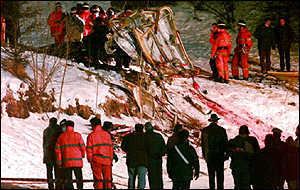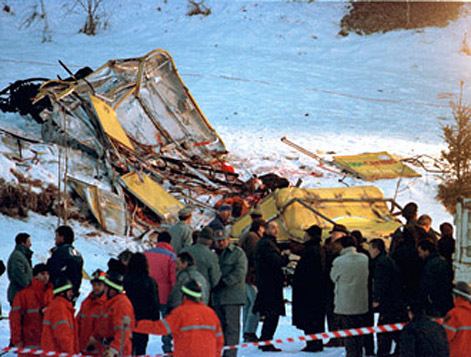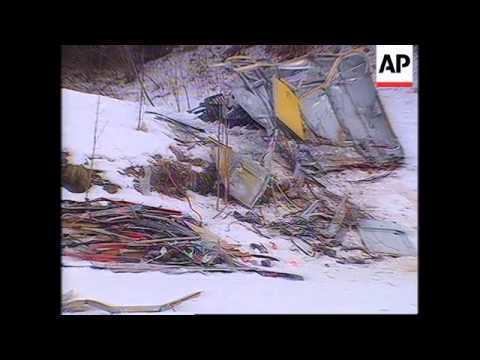Time 14:13 local time Number of deaths 20 | Date 3 February 1998 | |
Similar Kaprun disaster, Val di Stava dam collapse, Cebu Pacific Flight 387 | ||
Cavalese cable car disaster 1998
The Cavalese cable car disaster of 1998, also called the Strage del Cermis ("Massacre at Cermis") occurred on 3 February 1998, near the Italian town of Cavalese, a ski resort in the Dolomites some 40 km (25 mi) northeast of Trento. Twenty people died when a United States Marine Corps EA-6B Prowler aircraft, while flying lower than regulations allowed, cut a cable supporting a gondola of an aerial tramway, causing it to plunge 80 m (260 ft) to the ground. Joseph Schweitzer, one of the American aircrew, confessed in 2012 that upon return to the American base, he burned the tape that contained incriminating evidence. The pilot, Captain Richard J. Ashby, and his navigator, Captain Joseph Schweitzer, were put on trial in the United States and were found not guilty of involuntary manslaughter and negligent homicide. Later they were found guilty of obstruction of justice and conduct unbecoming an officer and a gentleman for having destroyed a videotape recorded from the plane and were dismissed from the Marine Corps. The disaster, and the subsequent acquittal of the pilots, strained relations between the United States and Italy.
Contents
- Cavalese cable car disaster 1998
- Details of the disaster
- Victims
- Reactions
- First trial
- Second trial and re examination
- US official report
- Compensation
- In popular culture
- References

Details of the disaster

On 3 February 1998, an EA-6B Prowler, BuNo (bureau number) 163045, 'CY-02', callsign Easy 01, an electronic warfare aircraft belonging to Marine Tactical Electronic Warfare Squadron 2 (VMAQ-2) of the United States Marine Corps, was on a low altitude training mission. At 14:13 local time it struck the cables supporting the aerial tramway-style cable car from Cavalese. The aircraft was flying at a speed of 540 miles per hour (870 km/h) and at an altitude of between 260 and 330 feet (80 and 100 m). When reaching approximately 46.283733°N 11.467237°E / 46.283733; 11.467237, the aircraft's right wing struck the cables supporting the cable car. The cable was severed causing the the cabin from Cermis with 20 passengers on board, plunged over 80 metres (260 ft) killing them all. The plane had wing and tail damage but was able to return to its base, Aviano Air Base.
Victims

Those killed, 19 passengers and one operator, were all Europeans: eight Germans, five Belgians, three Italians, two Poles, one Austrian and one Dutch.
Reactions

President Bill Clinton offered an official apology and promised monetary compensation. The then-United States Ambassador to Italy, Thomas M. Foglietta, visited the crash site and knelt in prayer, offering apologies on behalf of the United States.

In Italy, where the event received the name of Strage del Cermis (Italian: "The massacre of Cermis"), the low-level flight was strongly criticized and some politicians called for a re-evaluation of rules or a complete ban of such exercises.
First trial

Italian prosecutors wanted the four Marines to stand trial in Italy, but an Italian court recognized that North Atlantic Treaty Organization (NATO) treaties gave jurisdiction to U.S. military courts.
Initially, all four men on the plane were charged, but only the pilot, Captain Richard J. Ashby, and his navigator, Captain Joseph Schweitzer, actually faced trial, charged with 20 counts of involuntary manslaughter and negligent homicide. Ashby's trial took place at Marine Corps Base Camp Lejeune, North Carolina. It was determined that the maps on board did not show the cables and that the EA-6B was flying somewhat faster and considerably lower than allowed by military regulations. The restrictions in effect at the time required a minimum flying height of 2,000 feet (610 m); the pilot said he thought they were at 1,000 feet (305 m). The cable was cut at a height of 360 feet (110 m). The pilot further claimed that the height-measuring equipment on his plane had been malfunctioning, and that he had been unaware of the speed restrictions. In March 1999, the jury acquitted Ashby, outraging the European public. The manslaughter charges against Schweitzer were then dropped.
Second trial and re-examination
The two men were court-martialed a second time for obstruction of justice and conduct unbecoming an officer and a gentleman, because they had destroyed a videotape recorded from the plane on the day of the crash. The existence and destruction of this videotape only came to the attention of military investigators in August 1998, once Capt Chandler P. Seagraves received testimonial immunity and elected to disclose "the truth about everything." They were found guilty in May 1999; both were dismissed from the service and the pilot received a six-month prison term. He was released after four and a half months for good behavior. Schweitzer made a plea agreement that came to full light after the military jury deliberated upon sentencing. His agreement prevented him from serving any prison time, but it did not prevent him from receiving a dismissal.
In their appeal, Ashby and Schweitzer asked for a re-examination of their trial and for clemency, challenging their dismissals in order to be eligible for military benefits. They claimed that during the first trial the prosecutor and the defense secretly agreed to drop the involuntary manslaughter and negligent homicide charges, but to keep the obstruction of justice charge, in order to satisfy the requests coming from Italy. The appeal of Schweitzer was denied in November 2007.
Decisions from the Court of Appeals for the Armed Forces were made available in August 2009.
U.S. official report
In a formal investigation report redacted on 10 March 1998 and signed by General Peter Pace, the U.S. Marine Corps agreed with the results of the Italian officers. The investigation was led by General Michael DeLong, along with Italian Colonels Orfeo Durigon and Fermo Missarino. The document was kept secret until the Italian newspaper La Stampa legally obtained a copy from the United States archives and published it on 13 July 2011.
The Marine aircrew was determined to be flying too low and too fast, putting themselves and others at risk. The investigation team suggested that disciplinary measures against the flight crew and commanding officers should be taken, that the United States had to bear the full blame for what happened, and that victims' relatives were entitled to receive a monetary settlement.
The commission found that the squadron was deployed at Aviano on 27 August 1997, before the publishing of new directives by the Italian government forbidding flight below 2,000 feet (610 m) in Trentino Alto Adige. All the squadron's pilots received a copy of the directive. The letter was later found, unopened, in the cockpit of the EA-6B along with maps marking the cable car ropes.
In the report, the pilots are said to be usually well-behaved and sane, without any previous case of drug abuse or psychological stress. Nevertheless, on 24 January, they had received a formal warning for flying too low after a training take-off.
On 2 February Schweitzer planned the flight route for a low altitude training mission using obsolete documents. It was proved that the squadron commander, Lieutenant Colonel Muegge, and his assistants, Captains Roys, Recce, Watton, and Caramanian, did not alert the navigator about the new flight altitude limitations, maybe because the proposed flight had a lower ceiling of 1,000 feet (300 m), enough to be safe with any cable in the area. The report included an interview with the commander of 31st Fighter Wing, who stated that Muegge confessed to him that he and his crew except Ashby were aware of the current flight limitations. After approving the report, Pace suggested disciplinary measures be taken against the commanders, too.
On the morning of the disaster, the plane underwent maintenance due to a fault in the "G meter", which measures g-forces, and was replaced. The radar altimeter was checked and reported in normal condition. After the disaster, Ashby reported the radar altimeter did not alert, but this is disputed and highly unlikely. At the time of the disaster, the radar altimeter alert was set at 800 feet (240 m), but the plane was flying at less than 400 feet (120 m).
Ashby was qualified for low-altitude flight, but his last training mission of that kind was flown over six months before, on 3 July. The report includes flight tracing from a nearby AWACS airplane. The document reports a camcorder aboard the flight, but it was blank after Schweitzer had taken the original cassette and burned it afterwards.
Compensation
By February 1999 the victims' families had received USD $65,000 per victim as immediate help by the Italian government, which was reimbursed by the U.S. government. In May 1999, the U.S. Congress rejected a bill that would have set up a $40 million compensation fund for the victims. In December 1999, the Italian legislature approved a monetary compensation plan for the families ($1.9 million per victim). NATO treaties obliged the U.S. government to pay 75% of this compensation, which it did.
